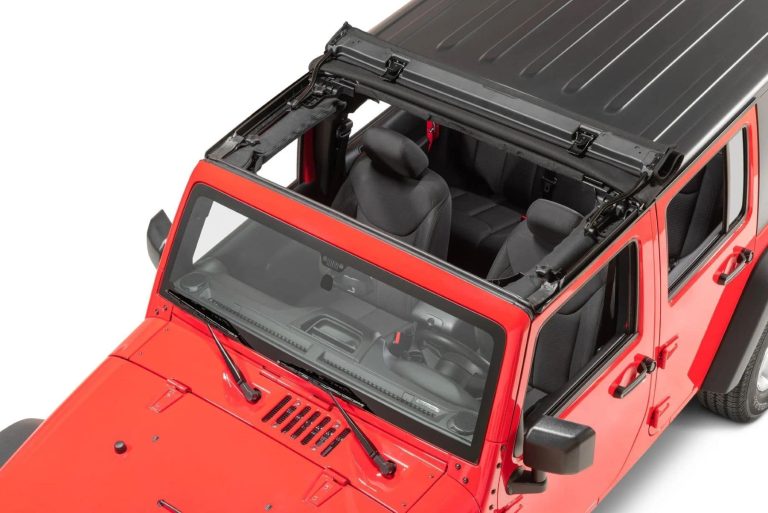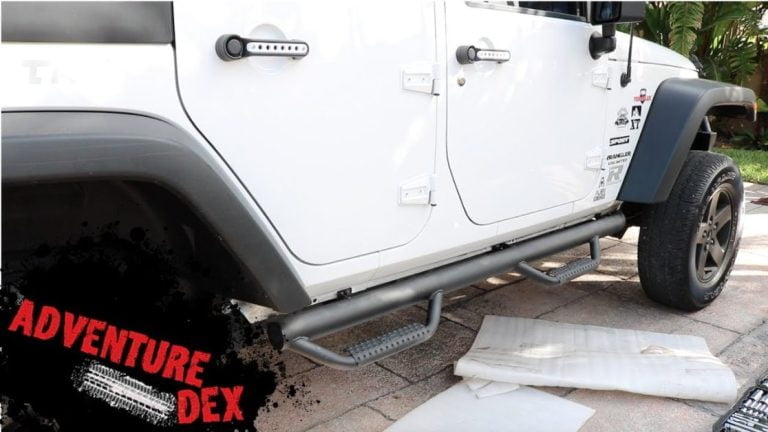What is a Transfer Case on a Jeep?
Curious about the mysterious component that allows your Jeep to seamlessly transition between driving modes?
The transfer case holds the key to unlocking your vehicle’s full off-road potential.
Dive into this intriguing world where gear ratios and torque reign supreme, and discover the crucial role it plays in conquering challenging terrain.
what is a transfer case on a jeep
The transfer case on a Jeep is a crucial component that facilitates the transition between two-wheel drive (2WD) and four-wheel drive (4WD) modes.
This mechanism utilizes a spline coupler, gears, and sometimes a chain to transfer power from the transmission to the front and rear axles via drive shafts.
By engaging a set of reduction gears, the transfer case can switch to a lower gear ratio when moving from high to low in 4WD.
This adjustment increases torque while reducing speed, enhancing the vehicle’s performance on challenging terrains.
Overall, the transfer case plays a vital role in synchronizing power distribution to the wheels, making it indispensable for off-road driving and rock crawling in a Jeep.
Key Points:
- Transfer case in a Jeep facilitates transition between 2WD and 4WD modes
- Utilizes spline coupler, gears, and sometimes a chain to transfer power to front and rear axles
- Can switch to lower gear ratio in 4WD to increase torque and enhance performance on tough terrains
- Synchronizes power distribution to wheels for off-road driving and rock crawling
- Important component for Jeep’s performance on challenging terrains
- Crucial for power distribution and mode switching in Jeep’s drivetrain
Check this out:
1. Function Of A Transfer Case On A Jeep
The transfer case on a Jeep plays a vital role in transitioning between 2WD and 4WD modes. It acts as a middleman between the transmission, distributing power to both the front and rear axles of the vehicle. By connecting a spline coupler with a gear driven by a chain or gears, the transfer case enables the transfer of power to the front drive shaft in 4WD mode. This functionality enhances traction and maneuverability in off-road situations, making it indispensable for Jeep enthusiasts tackling challenging terrains.
- The transfer case on a Jeep enables the shift between 2WD and 4WD modes.
- It acts as an intermediary component, distributing power to the front and rear axles of the vehicle.
- Engaging a spline coupler with a gear allows the transfer of power to the front drive shaft in 4WD mode.
2. Transitioning From 2Wd To 4Wd
- Moving from 2WD to 4WD in a Jeep involves engaging the transfer case to shift power distribution between the axles.
- By activating the transfer case, the Jeep harnesses the added traction of all four wheels working together, enhancing stability and control on slippery or uneven surfaces.
- The transition is typically accomplished by a simple flick of a lever or push of a button, making it an easy process for drivers to adapt to changing road conditions without compromising on performance.
3. Low Gear Ratio In 4WD
When switching to 4WD mode, the transfer case in a Jeep also enables the activation of a lower gear ratio known as “Low range.” This gear ratio adjustment results in increased torque output while sacrificing speed, allowing the Jeep to navigate through challenging terrain with greater ease. By reducing the speed to approximately one-third of its regular pace, the Jeep gains the necessary power and traction to conquer obstacles like steep inclines, rocky paths, or deep mud pits, showcasing the versatility and capability of the transfer case system.
4. Importance Of Selector Arm Movement
The movement of the selector arm is crucial for engaging the appropriate gears within the transfer case and transitioning between different driving modes. By adjusting the position of the arm, drivers can activate the spline coupler precisely, optimizing power distribution for specific road conditions. This control mechanism enables seamless adjustments between 2WD and 4WD modes, enhancing the performance and versatility of the Jeep in diverse driving scenarios.
- Selector arm movement is critical for engaging gears
- Position adjustment ensures precise activation of spline coupler
- Seamless transition between 2WD and 4WD modes
- Enhanced performance and versatility
“The selector arm is pivotal in transitioning between driving modes, ensuring optimized power distribution for various road conditions.“
5. Transfer Case In Different Vehicle Types
Transfer cases are not exclusive to Jeeps but are also found in various four-wheel-drive, all-wheel-drive, and multi-powered axle vehicles. These components play a vital role in synchronizing power distribution between the front and rear axles, allowing for improved traction and control in diverse driving conditions. Some vehicles may feature multiple low-range gears for off-road applications, while others may have electronically controlled transfer cases that automatically adjust power distribution based on road conditions, showcasing the versatility and adaptability of these systems across different vehicle types.
- Transfer cases found in various types of vehicles
- Role of transfer cases in power distribution
- Versatility of transfer case systems
“Transfer cases synchronize power distribution between front and rear axles, enhancing traction and control in varied driving environments.”
6. Power Transfer To Front And Rear Axles
The transfer case serves as a crucial link in transferring power from the transmission to the front and rear axles of the vehicle. By utilizing drive shafts and a combination of gears, hydraulics, or chains, the transfer case ensures that power is evenly distributed between the wheels, enabling a synchronized rotation and optimal traction on various surfaces. This seamless power transfer mechanism enhances the vehicle’s stability and performance, especially in off-road environments where traction and control are essential for navigating challenging terrains.
7. Off-Road Capabilities Of A Transfer Case
- Off-road enthusiasts rely on the capabilities of the transfer case to enhance their vehicle’s performance in rugged terrains.
- By engaging low-range gears and mechanically locking the front and rear drive shafts, the transfer case allows for better traction and control on uneven surfaces, steep inclines, or muddy trails.
- The ability to operate at slower speeds with increased torque in off-road conditions makes the transfer case a valuable asset for conquering challenging landscapes and pushing the boundaries of exploration in a Jeep.
8. Modes Of Operation For Transfer Cases
Transfer cases offer different modes of operation to suit various driving scenarios. Some transfer cases allow drivers to switch between two-wheel-drive and four-wheel-drive modes manually, providing greater control over power distribution. On the other hand, electronically controlled transfer cases automatically adjust power distribution based on traction requirements, optimizing performance in real-time. These diverse modes of operation cater to different preferences and driving conditions, ensuring a seamless driving experience for Jeep owners across a wide range of terrains.
- Manual switch between two-wheel-drive and four-wheel-drive modes
- Electronically controlled transfer cases for automatic power distribution
“Transfer cases offer different modes of operation to suit various driving scenarios.”
9. Control Mechanisms For Transfer Cases
- Transfer cases feature various control mechanisms that enable drivers to engage different gears and modes seamlessly.
- These control mechanisms, whether it’s a lever, switch, or electronic interface, allow for precise adjustments to power distribution, ensuring optimal performance in diverse driving conditions.
- Electronic control systems can automatically detect wheel slip and adjust power output accordingly, enhancing traction and stability on challenging surfaces.
- The versatility and adaptability of these control mechanisms make the transfer case a reliable and essential component for off-road driving in a Jeep.
10. Benefits Of Low-Range Gears
- Low-range gears in the transfer case offer several benefits for off-road driving and towing heavy loads.
- By providing increased torque at lower speeds, low-range gears enable the Jeep to navigate through challenging terrains with ease, maximizing traction and control.
- These gears are particularly useful for climbing steep inclines, traversing rocky paths, or pulling heavy trailers, enhancing the vehicle’s capability and performance in demanding situations.
- The presence of low-range gears showcases the versatility and adaptability of the transfer case system, making it an invaluable feature for Jeep owners who seek to push the limits of off-road exploration and adventure.
FAQ
How do I know if my Jeep transfer case is bad?
If your Jeep transfer case is bad, you may notice unusual sounds such as whining, growling, or humming. These noises can indicate issues like fluid leaks or damaged gears within the transfer case. Additionally, if your vehicle is experiencing problems shifting in and out of four-wheel drive mode, it could be a sign of a malfunctioning transfer case. It’s important to address these symptoms promptly to prevent further damage and ensure your Jeep’s drivetrain operates smoothly.
What happens when a transfer case goes bad?
When a transfer case goes bad, the vehicle may experience difficulties in shifting between gear ranges. This can be caused by fluid leakage from the transfer case, leading to a loss of fluid pressure that makes shifting gears more challenging. The lack of proper fluid pressure can make it harder to shift into higher or lower gears, impacting the overall performance and drivability of the vehicle. In severe cases, a malfunctioning transfer case may even prevent the vehicle from engaging certain gears altogether, causing further issues with driving and control. Regular maintenance and prompt repairs are important to address transfer case problems before they escalate and cause more extensive damage to the vehicle.
Can you drive a Jeep with a bad transfer case?
Driving a Jeep with a faulty transfer case is not recommended as it can further damage the vehicle and potentially require a full replacement instead of a simple repair. Continuing to drive with a bad transfer case can lead to additional issues and make the situation worse. It is best to address the problem promptly to prevent further damage and ensure the safety and functionality of the vehicle.
How much does it cost for a transfer case?
The cost of a transfer case replacement can vary significantly depending on the make and model of your vehicle. Replacement costs typically range from $2,000 to $8,000, with luxury or specialized vehicles on the higher end of the spectrum. On the other hand, repair costs for transfer cases will depend on the specific issue at hand and can be more cost-effective compared to a full replacement. It’s important to consult with a professional mechanic to accurately assess the necessary repairs and associated costs.
💡 Did You Know?
1. The transfer case on a Jeep is a vital component responsible for dividing power between the front and rear axles.
2. The transfer case is usually located in between the transmission and the rear driveshaft.
3. In some Jeep models, the transfer case has multiple settings such as 2-wheel drive, 4-wheel drive high, and 4-wheel drive low.
4. The transfer case is filled with lubricant to help reduce friction and heat generated by its moving parts.
5. Upgrading the transfer case can improve a Jeep’s off-road capabilities by providing better torque distribution to all four wheels.


